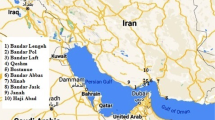Abstract
Genetic programming (GP) is an evolutionary algorithm-based methodology that employs a binary tree topology with optimized functional operators. This study introduced weight coefficients to each GP linkage in a tree in order to create a new weighted genetic programming (WGP) approach. Two distinct advantages of the proposed WGP include (1) balancing the influences of the two front input branches and (2) incorporating weights throughout generated formulas. Resulting formulas contain a certain quantity of optimized functions and weights. Genetic algorithms are employed to accomplish WGP optimization of function selection and proper weighting tasks. Case studies presented herein highlight a high-strength concrete reference study. Results showed that the proposed WGP not only improves GP in terms of introduced weight coefficients, but also provides both accurate results and formula outputs.







Similar content being viewed by others
References
Mehrjoo M, Khaji N, Moharrami H, Bahreininejad A (2008) Damage detection of truss bridge joints using artificial neural networks. Exp Syst Appl 35(3):1122–1131
Behzad M, Asghari K, Eazi M, Palhang M (2009) Generalization performance of support vector machines and neural networks in runoff modeling. Exp Syst Appl 36(4):7624–7629
Tsai HC (2009) Hybrid high order neural networks. Appl Soft Comput 9(3):874–881
Tsai HC (2010) Predicting strengths of concrete-type specimens using hybrid multilayer perceptrons with center-unified particle swarm optimization. Exp Syst Appl 37:1104–1112
Koza JR (1992) Genetic programming: on the programming of computers by means of natural selection. MIT Press, Cambridge
Baykasoglu A, Güllü H, Çanakçi H, Ozbakir L (2008) Prediction of compressive and tensile strength of limestone via genetic programming. Expert Syst Appl 35(1–2):111–123
Oltean M, Dumitrescu D (2002) Multi expression programming. Technical report UBB-01–2002. Babes Bolyai University, Cluj-Napoca
Ferreira C (2001) Gene expression programming: a new adaptive algorithm for solving problems. Complex Syst 13(2):87–129
Bhattacharya M, Abraham A, Nath B (2001) A linear genetic programming approach for modeling electricity demand prediction in Victoria. In: Proceedings of the hybrid information systems, first international workshop on hybrid intelligent systems, Adelaide, Australia, pp 379–393
Baykasoglu A, Oztas A, Ozbay E (2009) Prediction and multi-objective optimization of high-strength concrete parameters via soft computing approaches. Expert Syst Appl 36(3):6145–6155
Yeh IC, Lien LC (2009) Knowledge discovery of concrete material using genetic operation trees. Expert Syst Appl 36(3):5807–5812
Peng CH, Yeh IC, Lien LC (2010) Building strength models for high-performance concrete at different ages using genetic operation trees nonlinear regression, and neural networks. Eng Comput 26(1):61–73
Yeh IC (1998) Modeling of strength of high performance concrete using artificial neural networks. Cement Concr Res 28(12):1797–1808
El-Chabib H, Nehdi M, Sonebi M (2003) Artificial intelligence model for flowable concrete mixtures used in underwater construction and repair. ACI Mat J 100(2):165–173
Haj-Ali RM, Kurtis KE, Akshay R (2001) Network modeling of concrete expansion during long-term sulfate exposure. ACI Mat J 98(1):36–43
Kim JI, Kim DK, Feng MQ, Yazdani F (2004) Application of neural networks for estimation of concrete strength. ASCE J Mat Civil Eng 16(3):257–264
Stegemann JA, Buenfeld NR (2004) Mining of existing data for cement solidified wastes using neural networks. J Environ Eng 130(5):508–515
Yeh IC (2006) Exploring concrete slump model using artificial neural networks. ASCE J Comput Civil Eng 20(3):217–221
Holland JH (1975) Adaptation in neural and artificial systems. The University of Michigan Press, Ann Arbor
Gen M, Cheng R (1997) Genetic algorithms and engineering design. New York, Wiley
Michalewicz Z (1996) Genetic algorithms + data structures = evolution programs, 3rd edn. Springer, New York
Author information
Authors and Affiliations
Corresponding author
Rights and permissions
About this article
Cite this article
Tsai, HC., Lin, YH. Predicting high-strength concrete parameters using weighted genetic programming. Engineering with Computers 27, 347–355 (2011). https://doi.org/10.1007/s00366-011-0208-z
Received:
Accepted:
Published:
Issue Date:
DOI: https://doi.org/10.1007/s00366-011-0208-z




